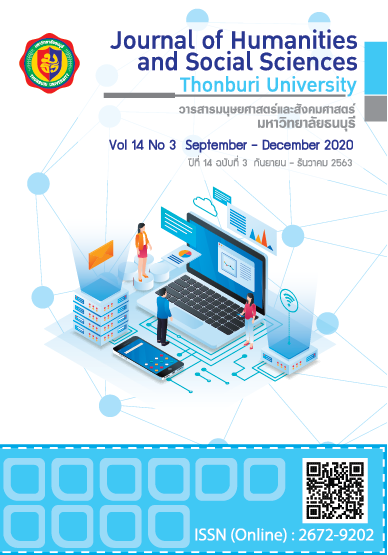The Participatory Development of a Cultural Tourist Attraction at LeamTukkae Sea Gypsy Village, Phuket Province
Keywords:
Attraction development, Cultural Tourism, Local Participation, Sea Gypsy, PhuketAbstract
Abstract
This research on the participatory development of a cultural tourist attraction at Leam Tukkae Sea Gypsy Village in Phuket province aims at examining the tourism potentials of the village with local participation, as well as, proposing approaches to its tourism development and management. This participatory research is hoped to lead to an improved level of more concrete planning, policy formulation, and support from local governments. The research employed the Participatory Action Research (PAR) method with four participatory parties, namely the community, the researcher, the private sector and implementers from the local government. Several research techniques were used which included focus group interviews, participatory observations, documentation analysis and village public hearings. The findings highlighted the outstanding tourism potential of the village as an ethnic tourism attraction with the strengths of local ways of life, history, language, and cultural performance. Its weaknesses were the unreadiness of tourist facilities and its lack of human capital at the community level. Its opportunities involved the current tourism policies of governments with financial and site support, whereas its crucial threat was the non-continuity of public support from involved governmental agencies. This participatory research proposed 10 possible approaches to the community’s tourism development and management. These involved the management of facilities, services, revenues, partnerships, safety, marketing, human resources, local involvement, products, and, finally, architecture. The research proposes an approach to success with public, private and community partnership (PPCP).
Keywords: Attraction Development, Cultural Tourism, Local Participation, Sea Gypsy, Phuket
References
กนกพร ฉิมพลี. (2559, มกราคม-เมษายน). แนวทางการพัฒนาหมู่บ้านท่องเที่ยวเชิงวัฒนธรรมในชุมชนบ้านตะคุ ตำบลตะคุ อำเภอปักธงชัย จังหวัดนครราชสีมา. วารสารชุมชนวิจัย, 10(1): 7-19.
กมลพิพัฒน์ ชนะสิทธิ์; และ นรินทร์ สังข์รักษา.(2561, พฤษภาคม-สิงหาคม). แนวทางการพัฒนาแหล่งท่องเที่ยวเชิงวัฒนธรรมตลาดน้ำคลองแดน อำเภอระโนด จังหวัดสงขลา. วารสารวิชาการมหาวิทยาลัยธนบุรี, 12(28): 163-176.
การท่องเที่ยวแห่งประเทศไทย [ททท.]. (2561). เป้าหมายองค์กร ปี 2561. การท่องเที่ยวแห่งประเทศไทย. สืบค้นเมื่อ 30 พฤษภาคม 2561, จาก https://www.tourismthailand.org/fileadmin/downloads/pdf/แผนปฏิบัติการ-ททท-ปี-2561.pdf
บุญเลิศ จิตตั้งวัฒนา. (2559). การจัดการตลาดอุตสาหกรรมท่องเที่ยว. พิมพ์ครั้งที่ 3. กรุงเทพ: เฟริ์นข้าหลวง พริ้นติ้งแอนด์พับลิชชิ่ง.
พัชรินทร์ จึงประวัติ. (2560, มกราคม-มิถุนายน). ความต้องการของชุมชนในการพัฒนาศักยภาพเพื่อการจัดการท่องเที่ยวเชิงอนุรักษ์: กรณีศึกษาการตลาดคลองสวนร้อยปี อำเภอบางบ่อ จังหวัดสมุทรปราการ. วารสารการบริการและการท่องเที่ยวไทย, 12(1): 36-49.
มหาวิทยาลัยสุโขทัยธรรมาธิราช [มสธ.]. (2561). วัฒนธรรมกับการท่องเที่ยว หน่วยที่ 1-14. นนทบุรี: มสธ.
ยุคลวัชร์ ภักดีจักรีวุฒ์ และเทิดชาย ช่วยบำรุง. (2562, ก.ค - ธ.ค.). ศักยภาพชุมชนด้านการส่งเสริมการตลาดการท่องเที่ยวแก่แหล่งท่องเที่ยวโดยชุมชน พื้นที่พิเศษเมืองพัทยาและพื้นที่เชื่อมโยง, วารสารวิชาการนวัตกรรมสื่อสารสังคม, 7(2): 254-264.
รัชฎา จิระธรรมกุล. (2559, มกราคม-มิถุนายน). แนวทางการพัฒนาแหล่งท่องเที่ยวชุมชนสร้างสรรค์ด้านวัฒนธรรมในชุมชนบ้านแขนน อำเภอถลางจังหวัดภูเก็ต. กระแสวัฒนธรรม, 17(31): 3-17.
ศตพล ใจสบาย; และ จุฑามาส ใจสบาย. (2559). การพัฒนาแหล่งท่องเที่ยวทางวัฒนธรรม: กรณีศึกษากลุ่มชาติพันธุ์ จังหวัดนครพนม. การประชุมวิชาการและนำเสนอผลงานวิจัยระดับชาติราชธานีวิชาการ ครั้งที่ 1, 29 กรกฎาคม 2559 (หน้า1176-1188). อุบลราชธานี: มหาวิทยาลัยราชธานี
ศิรินันท์ พงษ์นิรันดร; โอปัญญา บัวธรรม; และ ชัชชญา ยอดสุวรรณ. (2559). แนวทางในการพัฒนาศักยภาพการจัดการท่องเที่ยวอำเภอวังน้ำเขียว จังหวัดนครราชสีมา. วารสารวิทยาลัยบัณฑิตศึกษา การจัดการ มข, 9(1): 234-259.
ศูนย์มานุษยวิทยาสิรินธร. (2557). ทักษะวัฒนธรรมชาวเล. กรุงเทพ: ศูนย์มานุษยวิทยาสิรินธร.
อมาวสี อัมพันศิริรัตน์ และ พิมพิมล วงศ์ไชยา. (2560, พฤศจิกายน-ธันวาคม). การวิจัยเชิงปฏิบัติการแบบมีส่วนร่วม: ลักษณะสำคัญและการประยุกต์ใช้ในชุมชน. วารสารมนุษยศาสตร์และสังคมศาสตร์ มหาวิทยาลัยมหาสารคาม, 36(6). 2560: 192-202.
Dodds, R., & Butler, R.W. (2019). Overtourism: Issues, Realities and Solutions. Berlin: Walter de Gruyter.
Fennell, D. A. (2015). Ecotourism. 4thed. New York: Routledge.
Fennell, D.A., & Cooper, C. (2020). Sustainable Tourism: Principles, Contexts and Practices. Bristol: Channels View Publications.
International Council on Monuments and Sites: ICOMOS. (2017). ICOMOS ISC Cultural Tourism. Retrieved August 20, 2018, from http://icomos-ictc.org/wpcontent/uploads/2017/11/Publications-PDF-4-ICTC-Draft-Resolution-19th-General-Assembly-Final-En-31.10.2017.pdf
Morrison, A.M. (2019). Marketing and Managing Tourism Destinations. 2nded. New York: Routledge.
Sivesan, S. (2019). Challenges of Sustainable Tourism in Ancient Cities: A Case Study Based on Kandy, Sri Lanka. Journal of Business Studies, 6 (1): 57-74.
The United Nations (UN). (2018). The Sustainable Development Goals Report 2018. New York: UN.
Translated Thai References
Ampansirirat, A; & Wongchaiya, P. (2017, November-December). The Participatory Action Research: Key Features and Application in Community. Journal of Humanities and Social Sciences Mahasarakham University, 36(6): 192-202. (in Thai)
Bhadechakritwut, Y; & Choibamroong, T. (2019, July-December). Community Potential to Promote Tourism Marketing Of Tourist Attractions by the Community in the Special Governed City-Pattaya and the Related Areas. The Journal of Social Communication Innovation, 7(2): 254-264. (in Thai)
ChanaSith, K; & Sungrusa, N. (2018, May-August). Guidelines for the development of Cultural Tourism Klong Dan Floating Market Ranod District, Songkha Province. Journal of Thonburi University, 12(28): 163-176. (in Thai)
Chimplee, K. (2016, January-April). The Development of Village Cultural Tourism in Ban Takhu Pak Thong Chai District Nakhonratchasima Province. Community Research Journal, 10(1): 7-19. (in Thai)
Jaisabai, S; & Jaisabai, J. (2016). The Development of Cultural Tourism Attraction: A case Study of The Ethnic Group in Nakhon Phanom Province. Paper presented at The 1st National Conference, July 29, 2016 (1176-1188). Ubonratchathani: Rachathani University. (in Thai)
Jirathamakul. R. (2016, January-June). The Development Guidelines of Creative Cultural Community-Based Tourism of Ban Ka-nan Community, Thalang District, Phuket. Journal of Cultural Approach, 17(31): 3-17. (in Thai)
Jittangwattana. B. (2016). Tourism Marketing Management. 3rded. Bangkok: Fernkaluang Printings and Publishing. (in Thai)
Jungprawate, P. (2017, January-June). Community Needs in Developing Potential for Conservation Tourism Management: A Case Study of Klong San 100 Years Old Market, Bang Bo District, Samut Prakan Province. Journal of Thai Hospitality & Tourism,12(1): 36-49. (in Thai)
Phongnirand, S., Buatham, O; & Yodsuwan, C. (2016). Guidelines for Effective Development in Tourism Management of Wang Nam Khiao District, Nakhon Ratchasima Province. MBA-KKU Journal, 9(1): 234-259. (in Thai).
Princess Maha Chakri Sirindhorn Anthropology Centre [PMCSAC]. (2014). Cultural Skills of Sea Gypsea. Bangkok: PMCSAC. (in Thai)
Sukhothai Thammathirat Open University [STOU]. (2018). Culture and Tourism Unit 1-14. Nonthaburi: STOU. (in Thai)
Tourism Authority of Thailand [TAT]. (2018). Organisation Goals 2018. Retrieved May 30, 2018, from https://www. tourismthailand.org/fileadmin/downloads/pdf/แผนปฏิบัติการ-ททท-ปี-2561.pdf (in Thai)







